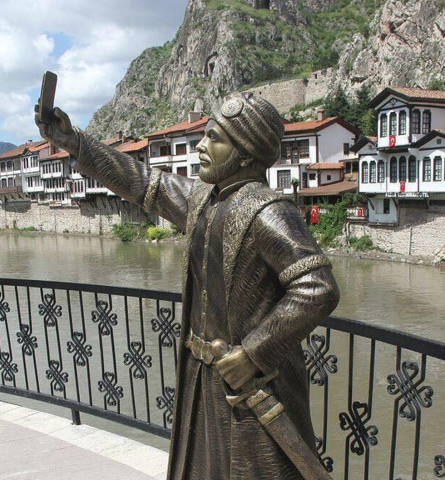Selfie Statue? Down Vote.
May 14,2015
Despite the statue being raised along an already popular riverbank, the responsible municipality officials claim to have done so in order to attract tourists. If that was truly the motive, it surely has succeeded. Hundreds of people, locals and foreigners alike, had visited the sight even before it was damaged, which was when most of the conversation began. Since then, it has been exposed to millions worldwide through the Internet. The tourists were attracted, but this was surely not the outcome that was expected.
Although this particular statue is not representative of a specific historical figure by name, any prince from the Ottoman Empire is usually recreated and reflected upon to emphasize their grandeur. In previous works, the subjects are remembered for their bravery; they can be seen dueling in famous battles, sitting on elaborate thrones, and the like. This prince, however, caught taking a photo of himself with his sword hanging limp at his side, is far less intimidating than its’ predecessors. In this work of art, the symbol of The Prince, previously signifying courage and heroism, is tainted by the very thing that makes it different: a cell phone.
While most of the dispute is in regards to “disrespect to Turkish ancestry” by publicly misrepresenting the nation’s heritage, artists have license to create whatever they please, regardless of how it may be interpreted by others. For example, this piece could have been an innocent attempt at humor and a way to draw a crowd. On the other hand, it could have been a stab at contemporary technological advances and the impact it has on the image of society.
The offense and insult that have resulted from the statue may not only be about any belittling of Turkish history, but possibly stems from a certain humiliation people have of their own habits. Heroism is rarely found in a world that is so caught up in the image of themselves and others. It can be said that selfishness has eaten away at our roots; social media swallowing more time than most people would care to admit. The Y Generation seems to be unconsciously embarrassed by its own customs, and to see them intertwined with an honorable makes them uncomfortable.
I don’t think that displaying the statue in such a public way was tasteful, and I think that it was expected to offend anyone, but it definitely spurred conversation and put our society in an alternative perspective. Turns out selfies aren’t so popular when it’s not you behind the camera.






